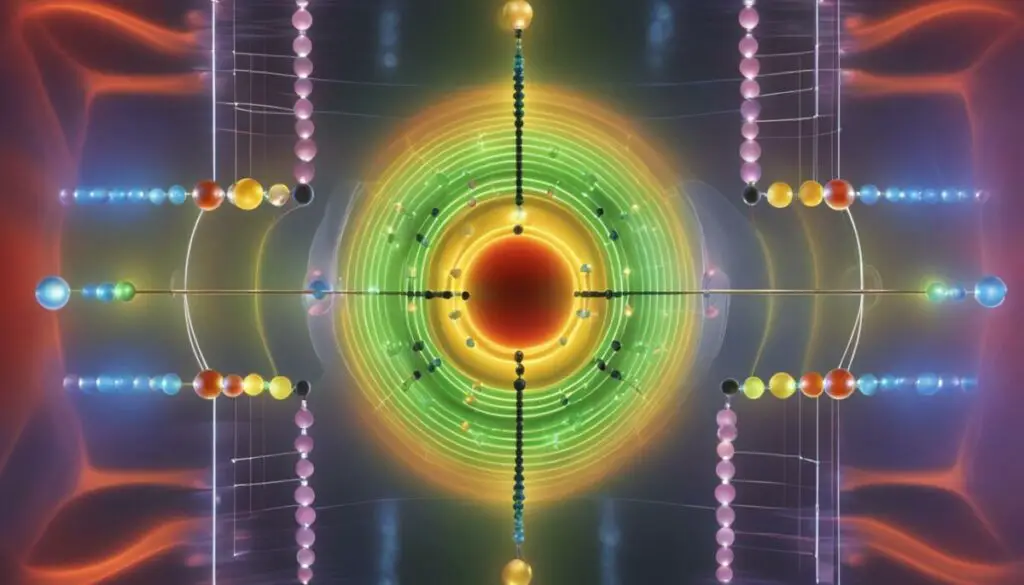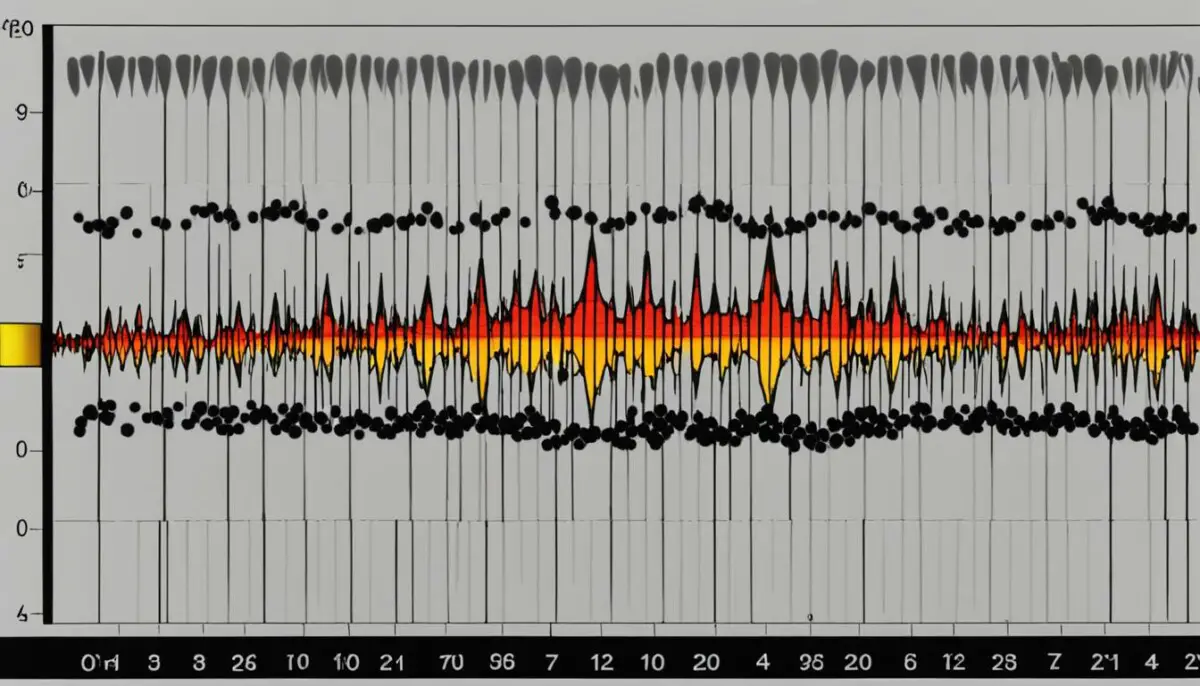Last Updated on 4 months by Francis
Ever wondered if a symmetric molecule can absorb infrared radiation? In this article, we will explore the fascinating world of infrared (IR) spectroscopy and its application in studying symmetric molecules. IR spectroscopy is a powerful tool for determining molecular structure and identifying chemical compounds, and understanding its principles can unlock a treasure trove of information.
When it comes to the absorption of infrared radiation, symmetric molecules play a unique role. Traditionally, it was believed that only molecules with net changes in dipole moment could absorb IR radiation. However, recent research has shown that even symmetric molecules can exhibit infrared absorption if there is a net change in dipole moment during their vibrational or rotational motion.
So, how does this work? As symmetric molecules vibrate or rotate, they can experience a temporary deviation from their symmetrical shape. This deviation leads to a change in the distribution of electrons, resulting in a temporary dipole moment. When infrared radiation interacts with these temporary dipoles, it can be absorbed, providing valuable information about the structure and properties of the molecule.
Contents
Key Takeaways:
- Symmetric molecules can absorb infrared radiation if there is a net change in dipole moment during their vibrational or rotational motion.
- Infrared spectroscopy is a powerful technique for determining molecular structure and identifying chemical compounds.
- Understanding the principles of IR spectroscopy can provide valuable insights into the properties of symmetric molecules.
- Temporary deviations from symmetrical shape create temporary dipoles, enabling the absorption of infrared radiation.
- By analyzing the infrared spectrum, scientists can gain a deeper understanding of the structure and properties of symmetric molecules.
Introduction to IR Spectroscopy

Infrared (IR) spectroscopy is a powerful analytical technique used to study the structure and identify chemical compounds. By analyzing the interaction of molecules with infrared radiation, IR spectroscopy provides valuable insights into the functional groups present in a compound, facilitating its identification and structure analysis.
One of the key principles of IR spectroscopy is that different functional groups absorb IR radiation at specific frequencies, resulting in characteristic absorption patterns, or spectra. These spectra serve as unique “fingerprints” that can be used to differentiate between different compounds and elucidate their molecular structure.
IR spectroscopy is widely used in both qualitative and quantitative analysis of organic and inorganic compounds. Qualitatively, IR spectroscopy helps in the identification of compounds by comparing their spectra to reference spectra databases. Quantitatively, it can be used to determine the concentration of specific compounds in a mixture.
In the field of organic chemistry, IR spectroscopy is particularly useful for identifying functional groups such as carbonyl (C=O), hydroxyl (–OH), amino (–NH2), and many others. Each functional group exhibits characteristic absorption bands in the IR spectrum, allowing chemists to quickly identify their presence.
The structure analysis capability of IR spectroscopy extends beyond functional groups. It can also detect structural features such as double bonds, triple bonds, and ring structures. This information is invaluable in organic synthesis, drug discovery, and other research areas that require precise characterization of compound structures.
“IR spectroscopy is a versatile tool for chemists, providing valuable insights into compound identity and structure. By harnessing the interaction between molecules and infrared radiation, researchers can unlock a wealth of information hidden within chemical compounds.”
The applications of IR spectroscopy are vast, spanning fields such as pharmaceuticals, forensics, environmental analysis, and materials science. Its non-destructive nature, ease of use, and ability to provide real-time results make it an essential technique in the analytical chemist’s toolkit.
In the next section, we will explore the different processes involved in absorption spectroscopy in IR, shedding light on rotational, vibrational, and electronic transitions that govern the interaction between molecules and infrared radiation.
Absorption Spectroscopy in IR

Absorption spectroscopy in IR involves three main processes: rotational transition, vibrational transition, and electronic transition. These processes result in an increase in energy proportional to the absorbed light. Each type of transition corresponds to different energy levels, with electronic transitions requiring the highest energy.
Rotational Transition
Rotational transition occurs when a molecule absorbs radiation and undergoes a change in its rotational state. As the molecule absorbs energy, it transitions from a low-energy rotational level to a higher-energy rotational level. This process is responsible for the fine structure observed in IR spectra.
Vibrational Transition
Vibrational transition involves the absorption of radiation by a molecule, resulting in a change in its vibrational state. Molecules have different vibrational modes, such as stretching and bending, which can absorb specific frequencies of infrared light. The absorption of energy causes the molecule to vibrate at a higher energy level corresponding to the absorbed frequency.
Electronic Transition
Electronic transition is the absorption of radiation by a molecule, leading to a change in its electronic state. This transition involves the excitation of electrons from lower-energy orbitals to higher-energy orbitals. Electronic transitions require the highest energy and are responsible for the electronic fine structure observed in the UV-Visible region.
To visualize these transitions, refer to the energy level diagram below:
“Absorption spectroscopy in IR allows us to study the rotational, vibrational, and electronic behavior of molecules. By analyzing the energy transitions that occur upon absorption, we can gain valuable insights into the molecular structure and composition.”
Diatomic Molecular Vibration

Diatomic molecules, composed of two atoms, possess only one vibration mode known as the vibrational modes. These molecular vibrations are described by the Hook’s law potential and the harmonic oscillator model, where the atoms oscillate back and forth around their equilibrium positions with a characteristic frequency.
However, it’s important to note that several factors can influence the diatomic molecule’s vibrational behavior, resulting in deviations from the harmonic oscillator model. For instance, anharmonicity arises when the potential energy curve is not perfectly parabolic, and the vibrational energy levels become non-equidistant.
Furthermore, rotational interactions between the diatomic molecule’s vibrational and rotational motions can affect the vibrational energy levels. As such, the observed vibrational frequencies may deviate from the values predicted by the harmonic oscillator model.
This deviation from the harmonic oscillator model can be visualized in the potential energy diagram of a diatomic molecule. The figure below illustrates the energy levels of a diatomic molecule as a function of the vibrational coordinate.
The deviations from the harmonic oscillator model are represented by the anharmonic oscillator potential energy curve. It demonstrates the non-equidistant spacing of energy levels and highlights the importance of considering anharmonicity in the vibrational analysis of diatomic molecules.
Polyatomic Molecular Vibration

Polyatomic molecules exhibit a range of vibrational modes, including stretching and bending modes, which play a crucial role in their chemical behavior. These vibrational motions can be described by different types of vibrations, such as stretching, scissoring, rocking, wagging, and twisting.
The number of vibrational modes in a polyatomic molecule depends on the number of atoms and the molecular geometry. Each mode corresponds to a unique pattern of molecular motion, contributing to the overall vibrational energy of the molecule.
Stretching modes involve the expansion and contraction of bonds between atoms. In these modes, the bond lengths change while the bond angles remain relatively constant. Stretching vibrations can be further classified into symmetric stretching and asymmetric stretching, depending on whether the atoms move in sync or out of phase, respectively.
Bending modes involve changes in the bond angles between atoms, while the bond lengths remain relatively constant. Bending vibrations can be classified as in-plane bending or out-of-plane bending, depending on the direction of atomic motion. In-plane bending occurs within the molecular plane, whereas out-of-plane bending involves motion perpendicular to the molecular plane.
Understanding the vibrational modes of polyatomic molecules is essential for interpreting their infrared absorption spectra. These spectra provide valuable information about the molecular structure and the presence of functional groups within the molecule.
In the next section, we will explore the practical aspects of infrared spectroscopy and how it is used to analyze polyatomic molecules.
Example of Vibrational Modes in Polyatomic Molecules
Let’s consider the water molecule (H2O) as an example of a polyatomic molecule. Water has three normal modes of vibration, which are:
- Stretching mode: In this mode, the two O-H bonds stretch symmetrically, resulting in an increase in the bond length.
- Bending mode: Water exhibits two bending modes: the symmetric and asymmetric bending modes. In the symmetric mode, both O-H bonds bend towards each other, while in the asymmetric mode, one bond bends towards the other.
| Vibrational Mode | Characteristics |
|---|---|
| Stretching Mode | Increase in bond length |
| Symmetric Bending Mode | Bending towards each other |
| Asymmetric Bending Mode | One bond bending towards the other |
Figure: Vibrational modes in a water molecule (H2O) showcasing stretching and bending motions.
Practical IR Spectroscopy

IR spectroscopy plays a crucial role in analyzing the molecular structure and identifying chemical compounds. This technique utilizes an infrared spectrometer to measure the interaction of molecules with infrared light. By measuring the transmittance or absorbance of infrared light at different frequencies, an IR spectrum is generated, offering valuable insights into the composition of the sample.
However, before obtaining accurate spectra, proper sample preparation is essential. Samples can be prepared in various forms, including solid films or liquid solutions, to ensure reproducible results. The precise preparation method depends on the nature of the sample and the desired analysis.
“IR spectroscopy provides a powerful tool for studying the vibrational and rotational properties of molecules. By examining the IR spectrum, scientists can identify functional groups and gain insights into the molecular structure.”
— Dr. Amanda Johnson, Analytical Chemist
Using an infrared spectrometer, the IR spectrum obtained from a sample can reveal valuable information about its chemical composition. The spectrum consists of a series of peaks and valleys representing the different frequencies at which the sample interacts with infrared light. By analyzing these peaks, scientists can identify specific functional groups and make accurate compound identifications.
As an example, let’s consider the spectrum of a compound containing a carbonyl group. The presence of the carbonyl group can be confirmed by observing a characteristic peak in the IR spectrum at around 1700 cm-1. This information can be used to differentiate between compounds that may have similar chemical structures but different functional groups.
| IR Spectrum Peaks | Functional Group |
|---|---|
| 1300-1000 cm-1 | C-H stretching vibrations |
| 3400-3200 cm-1 | O-H stretching vibrations (alcohols, carboxylic acids) |
| 2200-2100 cm-1 | C≡N stretching vibrations (nitriles) |
| 1650-1600 cm-1 | C=C stretching vibrations (alkenes) |
| 3400-3100 cm-1 | N-H stretching vibrations (amines) |
- Prepare the sample according to the chosen form (film, solution, etc.).
- Load the sample into the infrared spectrometer.
- Adjust the instrument settings and specify the desired spectral range.
- Initiate the analysis to obtain the IR spectrum.
- Analyze the obtained spectrum, identifying characteristic peaks and identifying functional groups present in the sample.
By following these steps and employing proper sample preparation techniques, scientists can leverage the power of IR spectroscopy to gain valuable insights into the molecular composition of various chemical compounds. Whether in research, forensics, or industrial applications, IR spectroscopy remains a cornerstone technique in analytical chemistry.
Theory and Frequency Range in IR Spectroscopy

Infrared (IR) spectroscopy operates within the electromagnetic spectrum, which is divided into three distinct regions for this analysis: near-infrared, mid-infrared, and far-infrared. Each region possesses its own energy levels and exhibits unique molecular properties. The frequency range utilized in IR spectroscopy spans from 1.9*1013 Hz to 1.2*1014 Hz, corresponding to wavelengths ranging from 2500 nm to 16,000 nm.
The near-infrared region lies closest to the visible spectrum, offering a frequency range between 1.9*1013 Hz and 1*1014 Hz. It is commonly used in applications such as molecular structural analysis, imaging, and sensing. The mid-infrared region, spanning from 1*1013 Hz to 3*1013 Hz, enables the identification of functional groups within molecules, making it invaluable in the field of organic chemistry. Finally, the far-infrared region operates between 3*1012 Hz and 1.9*1013 Hz, providing insights into molecular vibrations and solid-state properties.
Understanding the frequency range is crucial for identifying and analyzing molecular and electromagnetic properties using IR spectroscopy. By harnessing the electromagnetic spectrum across these distinct regions, scientists can unlock invaluable information about molecular structures and behavior.
The Electromagnetic Spectrum
IR spectroscopy utilizes distinct regions within the electromagnetic spectrum, each offering unique insights into molecular properties. The following table outlines these regions and their corresponding characteristics:
| Region | Frequency Range (Hz) | Wavelength Range (nm) | Characteristics |
|---|---|---|---|
| Near-infrared | 1.9*1013 – 1*1014 | 2500 – 10,000 | • Used for molecular structural analysis, imaging, and sensing • Offers high penetration depth in materials |
| Mid-infrared | 1*1013 – 3*1013 | 10,000 – 33,333 | • Enables identification of functional groups in molecules • Utilized in organic chemistry |
| Far-infrared | 3*1012 – 1.9*1013 | 33,333 – 100,000 | • Provides insights into molecular vibrations and solid-state properties • Useful in the study of semiconductors and crystal structures |
Vibrational Spectroscopy and Group Frequencies
Vibrational spectroscopy in IR (infrared) involves the excitation of vibrational modes in molecules, which play a crucial role in identifying chemical compounds. Different types of vibrations, such as stretching and bending, give rise to specific absorption frequencies that can be detected using an infrared spectrometer. These vibrational modes are essential for understanding the molecular structure and behavior of a compound.
The fundamental vibrations, also known as the normal vibrational modes, are the basic motions of atoms within a molecule. Each mode corresponds to a specific energy level and is characterized by its own unique frequency of absorption. By analyzing these absorption frequencies, scientists can determine the presence of functional groups in a compound, aiding in compound identification and structural analysis.
Combination tones and overtones are additional vibrational modes that can occur in more complex molecules. Combination tones are produced when two or more fundamental vibrations interact, resulting in new frequency components in the spectrum. Overtones, on the other hand, are higher energy vibrational modes that are multiples of the fundamental vibration frequency. These additional vibrational modes provide further insight into the molecular structure and dynamics.
Group frequencies are specific absorption bands that indicate the presence of functional groups in a compound. These group frequencies are characteristic and can be used to identify and classify organic molecules. By comparing the absorption bands of a sample to known group frequencies, scientists can determine the functional groups present, thereby aiding in compound identification.
For example, the presence of a carbonyl group (C=O) can be detected by the absorption band around 1650 cm-1. This characteristic group frequency is associated with the stretching vibration of the C=O bond. Similarly, other functional groups, such as hydroxyl groups (OH), alkyl groups (CH3), or amide groups (C=O-NH), have specific absorption bands that can be used for identification.
Vibrational spectroscopy and the analysis of group frequencies play a vital role in various fields, including chemistry, material science, pharmaceuticals, and forensics. The combination of vibrational modes and group frequencies provides valuable insights into the structure, composition, and behavior of molecules, enabling scientists to better understand the properties and functions of chemical compounds.
| Functional Group | Absorption Band (cm
-1
) |
|———————–|——————————————|
| Carbonyl (C=O) | 1650–1750 |
| Hydroxyl (OH) | 3200–3600 |
| Amine (NH) | 3300–3500 |
| Alkane (C-H) | 2850–3000 |
| Alkene (C=C) | 1640–1680 |
| Aromatic (C=C) | 1450–1600 |
| Nitro (NO
2
) | 1500–1600, 1300–1400 |
Table: Examples of group frequencies for common functional groups found in organic compounds. These absorption bands represent characteristic vibrational modes associated with specific functional groups. By comparing the absorption bands present in the infrared spectrum of a compound to these group frequencies, scientists can identify the functional groups present.
Conclusion
Infrared spectroscopy is a powerful technique that allows scientists to determine the molecular structure and identify chemical compounds. By analyzing the unique patterns present in infrared spectra, researchers can gain valuable insights into the presence of specific functional groups, aiding in accurate compound identification.
The infrared spectra obtained through this technique serve as fingerprints for different compounds, representing their distinctive molecular vibrations. These vibrations produce characteristic absorption bands in the infrared region, forming a molecular “barcode” that can be compared to known spectra for identification purposes.
The ability to interpret infrared spectra and understand the molecular structure of compounds has widespread applications in various fields, including chemistry, pharmaceuticals, forensics, and environmental analysis. Through the use of infrared spectroscopy, scientists can analyze and identify a wide range of samples, including organic and inorganic compounds, solids, liquids, and gases.
FAQ
Can a symmetric molecule absorb infrared radiation?
Yes, symmetric molecules can absorb infrared radiation if there is a net change in dipole moment as they vibrate or rotate.
What is IR spectroscopy used for?
IR spectroscopy is commonly used to study the structure and identify chemical compounds, both organic and inorganic.
What are the main processes involved in absorption spectroscopy in IR?
The main processes involved in absorption spectroscopy in IR are rotational transition, vibrational transition, and electronic transition.
How do diatomic molecules vibrate?
Diatomic molecules have only one vibration mode, which can be described by the Hook’s law potential and the harmonic oscillator model.
What are the vibrational modes in polyatomic molecules?
Polyatomic molecules have multiple vibrational modes, including stretching and bending modes, which can be described by different types of vibrations.
How is IR spectroscopy performed?
IR spectroscopy is performed using an infrared spectrometer, which produces an IR spectrum displaying the transmittance or absorbance of infrared light at different frequencies.
What is the frequency range for IR spectroscopy?
The frequency range for IR spectroscopy is from 1.9*1013 to 1.2*1014 Hz, with wavelengths ranging from 2,500 to 16,000 nm.
How do different types of vibrations in molecules give rise to specific absorption frequencies?
Different types of vibrations, such as stretching and bending, give rise to specific absorption frequencies, which can provide information about the presence of functional groups in a compound.
What can be determined from analyzing infrared spectra?
Analyzing infrared spectra can provide insights into the molecular structure and aid in the identification of chemical compounds based on their unique patterns.
Source Links
- https://en.wikipedia.org/wiki/Infrared_spectroscopy
- https://www2.chemistry.msu.edu/faculty/reusch/virttxtjml/spectrpy/infrared/infrared.htm
- https://chem.libretexts.org/Bookshelves/Physical_and_Theoretical_Chemistry_Textbook_Maps/Supplemental_Modules_(Physical_and_Theoretical_Chemistry)/Spectroscopy/Vibrational_Spectroscopy/Infrared_Spectroscopy/Infrared_Spectroscopy








